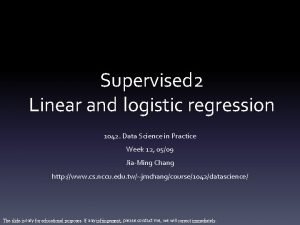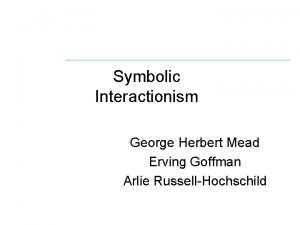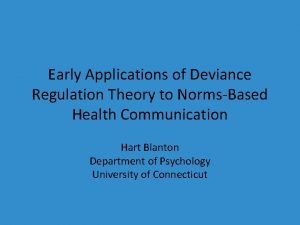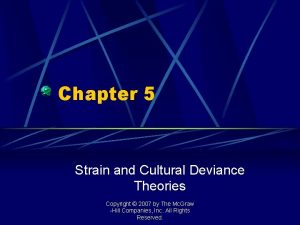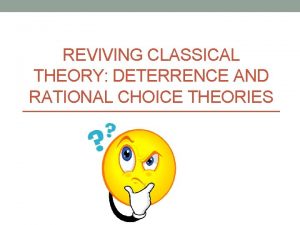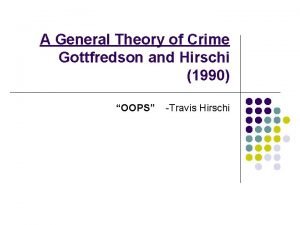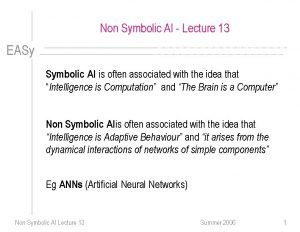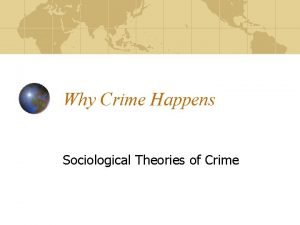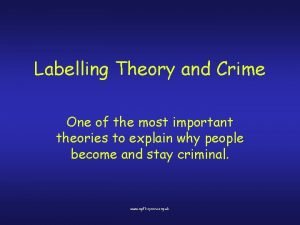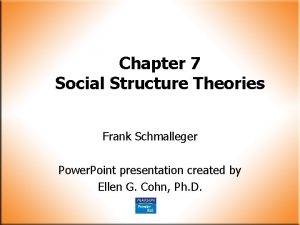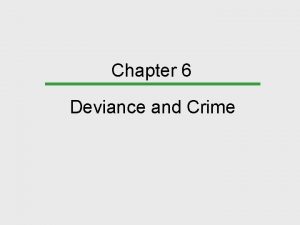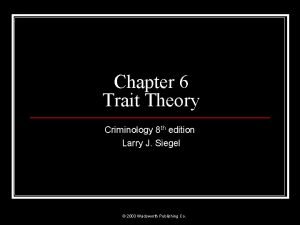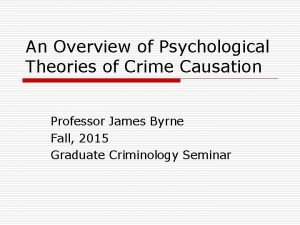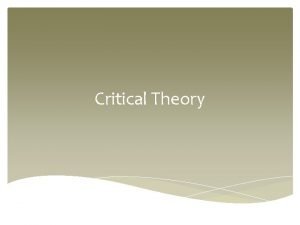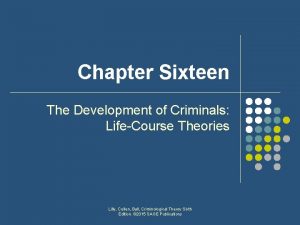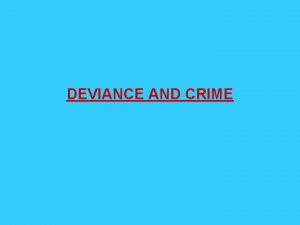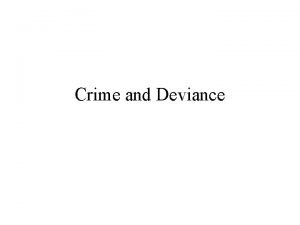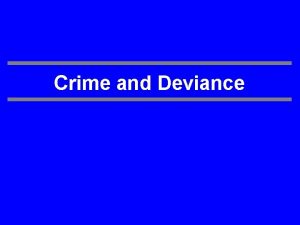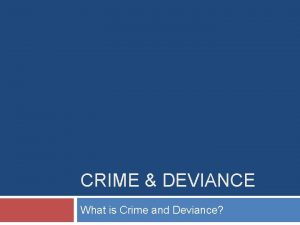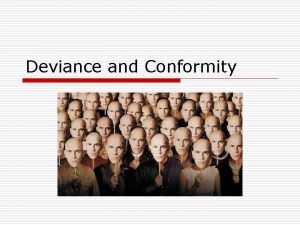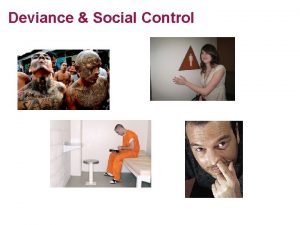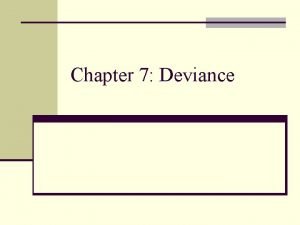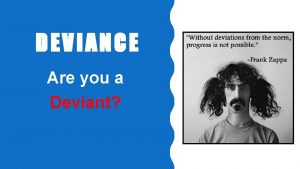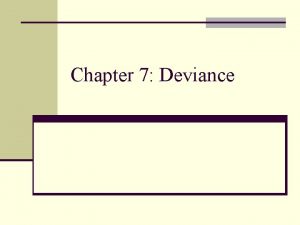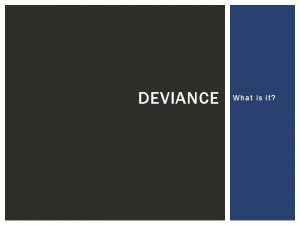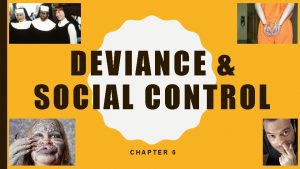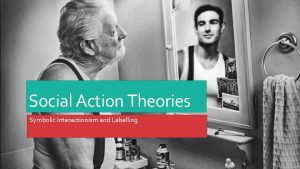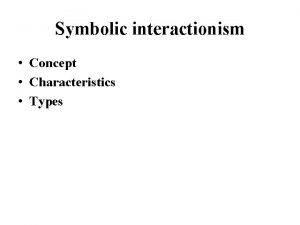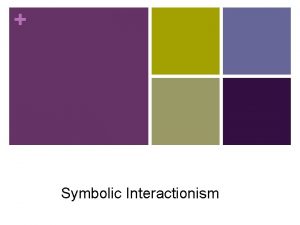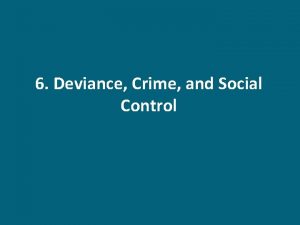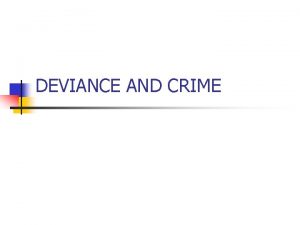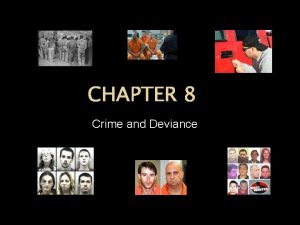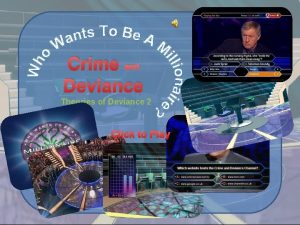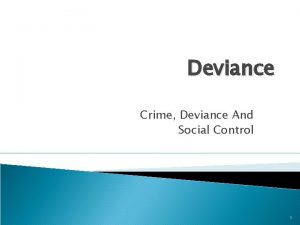Interactionism and crime and deviance Micro theory Interactionism

























- Slides: 25

Interactionism and crime and deviance Micro theory Interactionism: small scale micro theory, focuses on interactions between individuals and groups, rather than the large scale workings of society. Interactionists seek to understand the meanings that social actors give to actions and situations Instead of seeking the causes of criminal behaviour, they ask how and why some people and actions come to be labelled as criminal or deviant, and what effects this has on those who are labelled

What is deviant behaviour • Functionalist and subcultural theories both assume that mainstream culture has a consensus about what criminal and deviant behaviour is • They also see deviants as something ‘other’ – a group different to ‘normal’ society • From an interactionist perspective there is no deviance – there are only acts that are labelled as deviant

Official statistics • Regard them as social constructions. They are not valid in any way. This reflects the origins of labelling theory in symbolic interactionism, which takes the view that individuals construct the social world through their face to face interactions • Crime is a product of interactions between suspects and police for example rather than the result of wider external social forces such as blocked opportunity structures

The social construction of crime • Rather than taking the definition of crime for granted. Labelling theorists are interested in how and why certain acts come to be defined or labelled as criminal or deviant in itself, in all situations and at all times • Instead, it only comes to be so when others label it as such. In other words it is not the nature of the act that makes it deviant, but the nature of societys reaction to the act • There is nothing fixed about what is right or wrong. However, whether the label of ‘criminal’ is applied will depend on how the ‘act’ is interpreted by the ‘audience’ • Who commits the act, location when the act is committed, time of day and historical period, who observes the act, the negotiations between the various actors involved in the situation • Interactionists see the official statistics as socially constructed, in part because the CJS tells sociologists more about the activities of the police and prosecution than the amount of crime there is or who commits it • Labelling theorists are interested in how and why laws got made • Laws are invariably made by moral entrepreneurs, thus, they argue that laws are really socially constructed • Those in power have the ability to determine what is or isn’t criminal. Northing is inherently deviant of criminal • Eg platt argued that the idea of juvenile delinquency was originally created as a result of a campaign by Victorian entrepreneurs, aimed at protecting young people at risk from sexual promiscuity

Becker

• Interactionists suggest that law breakers are not different to the law abiding • Labelling theory suggests that most people commit crimes, but only some are caught and stigmatised • Thus, becker states: ‘crime (and deviance) is behaviour people so label’ • An act on its own isn’t criminal until someone has the power to label it as such • Just because someone breaks a rule, it doesn’t necessarily mean that others will see it as criminal • Someone has to enforce the rule/ they have a vested interest in this issue • If a person is successfully labelled then consequences follow

Moral entrepreneurs: rule creators and rule enforcers • Moral entrepreneurs: describes those persons in power who campaign to have certain deviant behaviour outlawed. He described those who take the lead in labelling a particular behaviour and spreading or popularising this label throughout society • Moral entrepreneurs fall into two categories: rule creators and rule enforcers • Rule creators generally express the conviction that some kind of threatening social evil exists that must be combated. Successful moral crusades are generally dominated by those in the upper social strata of society such as clergy, the media, business community, politicians. • After a time, crusaders become dependent upon experts/professionals to execute and apply the rules. Rule enforcers such as police fulfil this role • The creation and application displays the tendency of both rule creators and rule enforcers treat people as enemies, thereby introducing a feeling of superiority and remoteness over the people whose behaviour they regulate • Thus, most likely targets of both rule creators and rule enforcers are those who are socially inferior, culturally different, and personally unknown. They become the ‘outsiders’ and form gangs and subcultures

Who gets labelled • Not everyone who commits an offence is punished for it, whether a person is arrested, charged and convicted depends on factors such as: • Their interactions with agencies of social control- eg elaborated or restricted code • Their appearance, background and personal biography • The situation and circumstances of the offence • Becker argues that is the offender accepts their label as a criminal, this may well develop a ‘deviant career’. This may lead to them becoming outsiders and this will ultimately become their master status and others who treat them accordingly

Lambert

• Whilst the police may claim that the law is applied equally and fairly, work by lambert claims that: • The police have considerable discretion and play a major role in constructing crime statistics, even though they are expected to follow the police rule book • Limited resources of the police mean that they concentrate on: inner city area, s w/c areas • The police are able to decide who to stop, search, investigate, arrest and charge • The way the person responds to the police will partly determine the outcome • Those who are cooperative are less likely to be arrested than those regarded as disrespectful • Lambert suggests that m/c are more likely to be more polite when arrested • Given that police officers, like everyone have career and promotion prospects they may be zealous in their decision to carry out an arrest and this could well result in the prosecution of particular groups in society

Piliavin and briar • Found that police decisions to arrest a youth were mainly based on physical cues such as manner and dress. Being scruffy was a key determinant in whether people would be apprehended

Lemert

Primary and secondary deviation • Argues that societal reaction is the cause of deviance • He distinguished between primary and secondary deviation • Primary deviation: consists if deviant acts before they are publically labelled. He argued that the odd deviant act has little effect on a persons self image and status in the community. It doesn’t prevent them from continuing a normal and conventional life • Secondary deviance: is the public identification of the deviant, and the consequences for the individual concerned. This has major consequences for the individuals self concept, status in the community and the individuals actions. The original causes of deviation recede and give way to the central importance of disapproving, degradational, and isolating reactions of society • Thus, societal reaction is the major cause of deviance • The work of lemert illustrates that its not the act itself, but the hostile reaction by the social audience, that creates serious deviance • The social control processes that are meant to produce law abiding behaviour may in fact produce the opposite

Cohen: deviance amplification spiral

• Is a process in which the attempt to control deviance leads to an increase in the level of deviance • 1: initial act of deviance -> 2: media publicises deviant/criminal act -> 3: moral panic and moral crusaders eg clergy, journalists, politicians call for police to tackle deviancy -> 4: police focus extra resources on criminal/deviant act -> 5: police find more deviancy and it becomes amplified

Mods and rockers (a 02) • 1: mods and rockers fight in seaside resort • 2: media publicises criminal activity • 3: politicians raise concerns about the behaviour of the youth of today and assert a moral crusade – moral panic begins • 4: next bank holiday more police sent to seaside resorts • 5: mods and rockers think that there will be more trouble and travel to seaside towns

The application of labelling: homosexuality (becker and plummer) 70 s

Becker • Interviewed 700 college students, found that when an individuals behaviour is called into question and the label homosexual applied a subject tends to reinterpret the individuals past behaviour in light of new information • In many cases their label was seen to activate statements and responses in others eg contempt, rejection, that was previously alien to that view of the individual

Plummer • Sees 4 stages in the development of homosexual careers: • Stage 1: sensitisation (self labelling): realises theyre homosexual • Stage 2: signification: identity crisis – secrecy, guilt • Stage 3: sub-culturalisation: coming out • Stage 4: stabilisation: proud to be gay • A 03: is it outdated

Labelling and mental illness: rosenham

• Was interested in how people came to be identified as insane and developed an experiment to see how the staff of mental hospitals made sense of the patients who behaved normally • Research volunteers sought medical help claiming that they were hearing voices- common symptom of schizophrenia • Admitted to 12 hospitals where they ceased to simulate any symptoms, but despite their normal behaviour none of the volunteers were recognised as fakes • All were eventually diagnosed as schizophrenic and all discharged with the illness being in remission • Part 2: rosenham reversed the experiment by telling staff to expect people to gain admittance by faking illness • 40 out of 200 were identified as being suspicious even though they were genuinely seeking help • He argues that any diagnostic process lends it so readily to massive errors of this sort cant be very reliable • His research is a challenge to the superiority claimed by biomedicine in the area

Cicourel Phonomenologist

The recognition of juvenile justice • • According to him, officers are influenced by their stereotypes of offenders However, he found that other agencies of social control within the cjs reinforced his bias He carried out a participant observation by working as a clerk to the courts of three and a half years He discovered that probation officers held the common sense theory that juvenile delinquency was caused by broken homes, lax parenting and poverty • Therefore they tended to see youth from such backgrounds as likely to offend in future and were less likely to support noncustodial sentences for them • In cicourels view, justice is not fixed but negotiable eg when a m/c youth was arrested he was likely to be charged • This was partly because his background did not fit the idea of the policies ‘typical delinquent’ and partly because his parents were more likely to be negotiate on his behalf • The parents were able to convince the control agencies that he was sorry, that he would stay out of trouble in the future • As a result, he was typically ‘counselled and released’ rather than prosecuted • Thus, cicourel is suggesting that these statistics cannot be used as an accurate source about crime • He argues due to police using typificants, crime statistics say more about the way the police operate than actual levels of crime

A 03 of interactionism

Strengths • Good at showing the role of those in power • Highlights the relative nature of deviance • Shows how labels stick if they are given by those in authority, and can be discriminatory weaknesses • Ignores the victim and romanticises the criminal • Assumes once a criminal always a criminal • Overlooks serious consequences of criminal actions eg murder • Ignores the macro causes of crime eg the impact of capitalism • Ignores the processes that leads to deviancy • Ignores white collar and corporate crime
 Pseudo r-square
Pseudo r-square Crime and deviance sociology revision
Crime and deviance sociology revision Chapter 7 deviance crime and social control
Chapter 7 deviance crime and social control Difference between crime and deviance
Difference between crime and deviance Myra mawby
Myra mawby Marxism crime and deviance
Marxism crime and deviance Erving goffman symbolic interactionism
Erving goffman symbolic interactionism Deviance regulation theory
Deviance regulation theory Define cultural deviance theory
Define cultural deviance theory A repetition of or return to criminal behavior
A repetition of or return to criminal behavior Deterrence and rational choice theory of crime
Deterrence and rational choice theory of crime Gottfredson and hirschi’s general theory of crime
Gottfredson and hirschi’s general theory of crime Symbolic and non symbolic interactionism
Symbolic and non symbolic interactionism Symbolic interactionist perspective on poverty
Symbolic interactionist perspective on poverty Sociological perspective of crime
Sociological perspective of crime Labelling theory crime
Labelling theory crime Social structure theory crime
Social structure theory crime Functionalist theory of crime
Functionalist theory of crime Integrated theory of crime
Integrated theory of crime Questions about conflict theory
Questions about conflict theory Developmental theories
Developmental theories Trait theory in criminology
Trait theory in criminology Neoclassical theory of crime
Neoclassical theory of crime Psychological theory of criminal behavior
Psychological theory of criminal behavior Critical theory conflict theory
Critical theory conflict theory Life course theory crime
Life course theory crime
